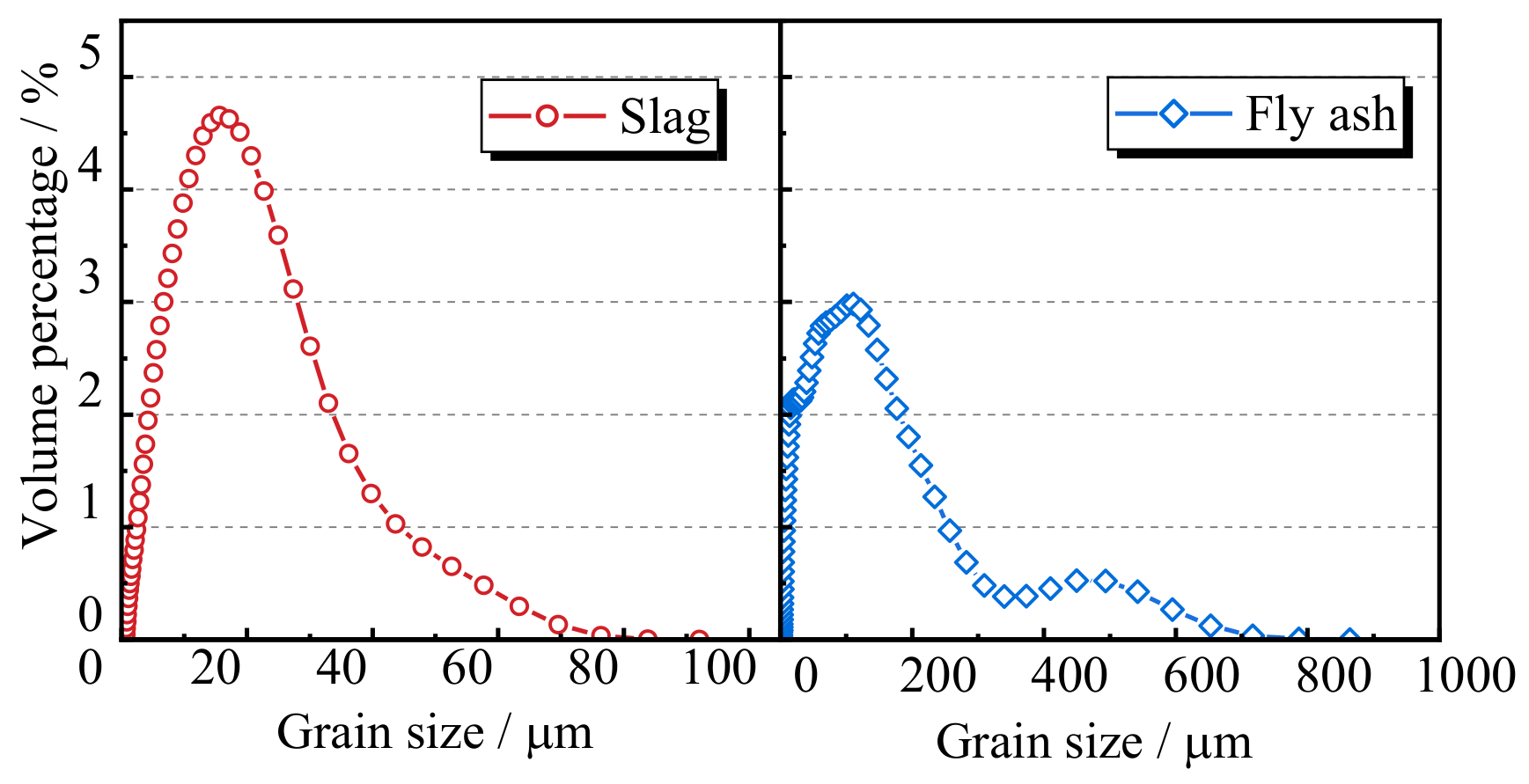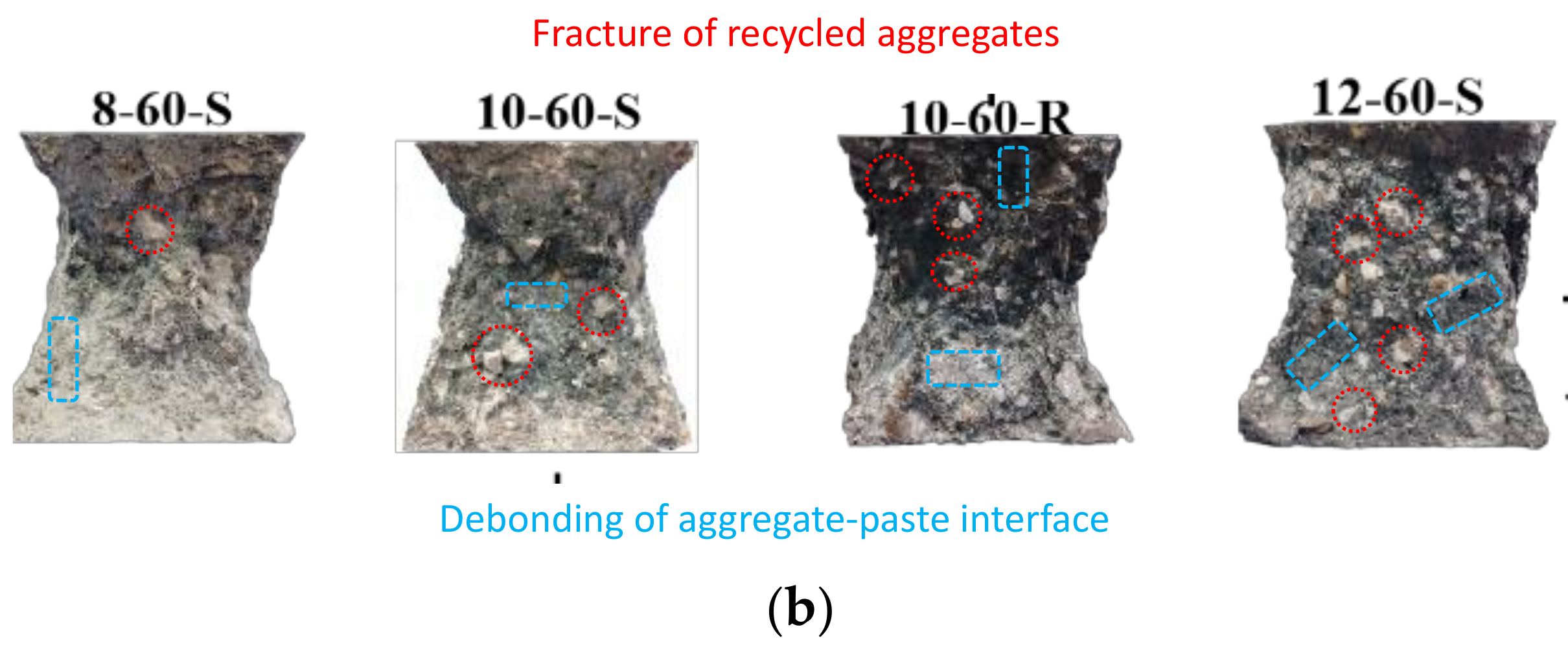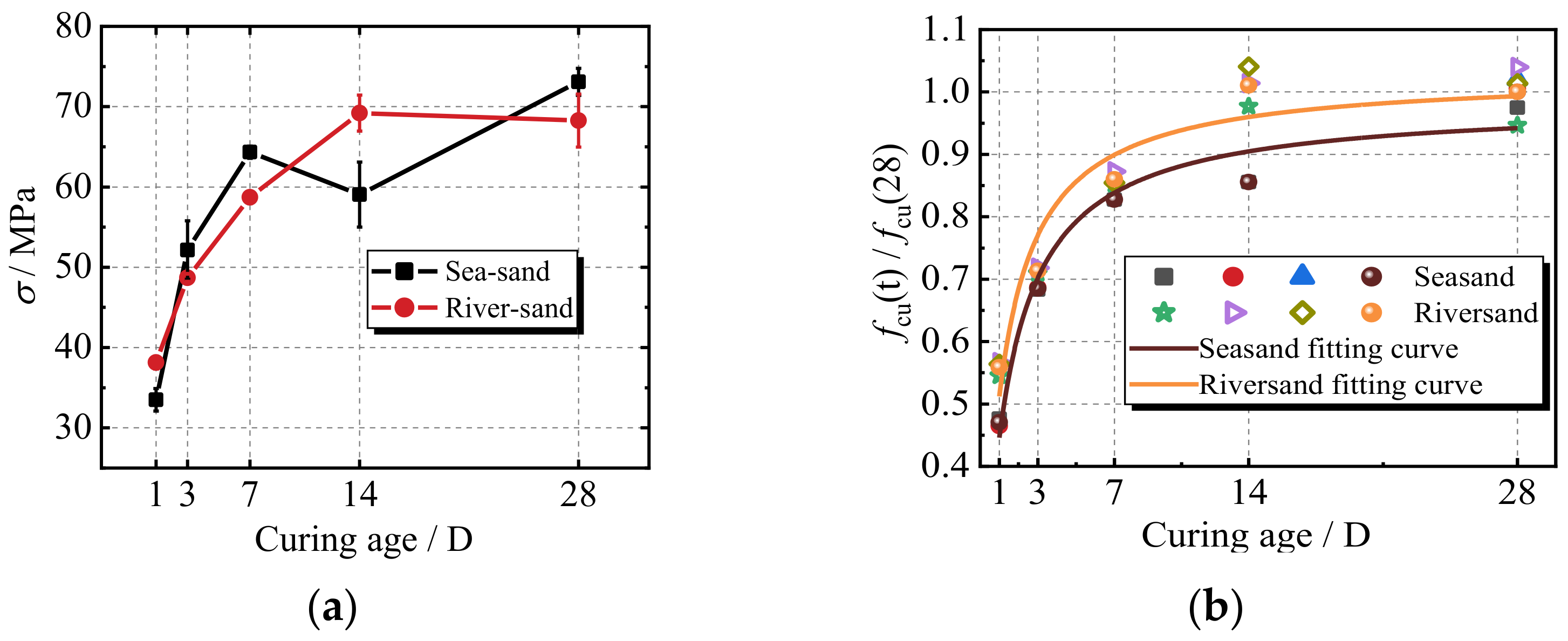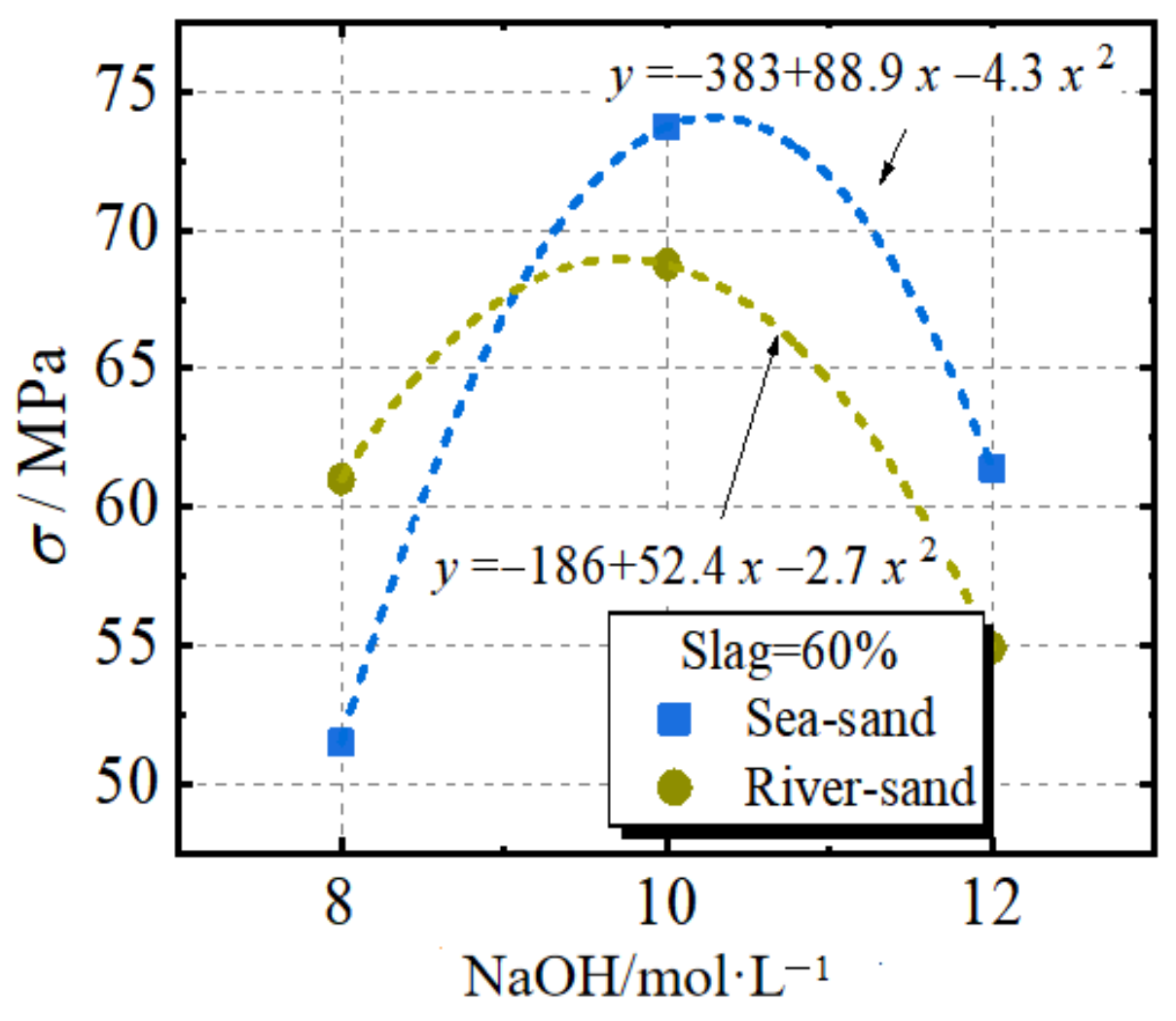Experiment on Compressive Properties and Microscopic Analysis of Sea Sand Geopolymer-Based Recycled Concrete
Abstract
:1. Introduction
2. Experimental Results
2.1. Experimental Materials
2.2. Specimen Design
2.3. Test Method
3. Test Results and Failure Mechanism Analysis
3.1. The Compressive Failure Pattern
3.2. Micromorphology Analysis
3.3. The Curves of Compressive Stress–Strain for the Specimens
4. Analysis of Influencing Factors
4.1. The Effect of Curing Ages on Compressive Strength
4.2. The Effect of Slag Rate Concentration and NaOH Molarity on Compressive Strength
5. Numerical Compressive Stress–Strain Relationship
6. Conclusions
- As the curing age increases, the color of the failure surface changes from dark to light. Additionally, the increase in the NaOH molarity can effectively improve the bonding performance, resulting in cracks in the RCAs instead of interface debonding.
- According to the SEM analysis, it is shown that the geopolymerization product can fill the voids of the porous aggregate particles and provide a favorable bonding performance between the paste and the RCAs.
- The stress–strain curve of geopolymer concrete is similar to the compressive stress curve of ordinary concrete. The compressive strength of geopolymer concrete at 1 and 7 days can reach 56% and 86% of the compressive strength at 28 days. The geopolymer concrete exhibits a rapid increase in compressive strength. The relationship between the strength and curing age for the geopolymer concrete with sea sand and river sand is proposed.
- For the specimens with a fixed NaOH concentration of 10 mol/L, with the increase in the slag replacement rates from 20% to 60%, the improvement in the compressive strength is achieved and is over 100%. Meanwhile, the increase in the elastic modulus is also observed. Replacing river sand with sea sand is feasible in terms of compressive strength.
- For both the sea sand and river sand, the optimum molarity value of the NaOH solution is around 10 M. Compared with the molarities of 8 M and 12 M, the compressive strength when the molarity is 10 M increases by 53.7% and 17.6%, respectively, for concrete with sea sand. For concrete with river sand, the increase in compressive strength when the molarity is 10 M is 25.9% and 12.6%. The NaOH solution can accelerate the geopolymerization process. An excessive alkaline environment causes the precipitation of the geopolymerization product. The relationship between the molarity of the NaOH solution and the compressive strength is established.
- Based on the experimental data, a modified compressive constitutive model for geopolymer recycled concrete is proposed that considers the curing age. The calculated curves are consistent with the test results.
Author Contributions
Funding
Institutional Review Board Statement
Informed Consent Statement
Data Availability Statement
Conflicts of Interest
References
- Pasupathy, K.; Sanjayan, J.; Rajeev, P.; Law, D.W. The effect of chloride ingress in reinforced geopolymer concrete exposed in the marine environment. J. Build. Eng. 2021, 39, 102281. [Google Scholar] [CrossRef]
- De Lena, E.; Spinelli, M.; Gatti, M.; Scaccabarozzi, R.; Campanari, S.; Consonni, S.; Cinti, G.; Romano, M.C. Techno-economic analysis of calcium looping processes for low CO2 emission cement plants. Int. J. Greenh. Gas Control 2019, 82, 244–260. [Google Scholar] [CrossRef]
- Dhondy, T.; Remennikov, A.; Shiekh, M.N. Benefits of using sea sand and seawater in concrete: A comprehensive review. Aust. J. Struct. Eng. 2019, 20, 280–289. [Google Scholar] [CrossRef]
- Tam, V.W.Y.; Soomro, M.; Evangelista, A.C.J. A Review of Recycled Aggregate in Concrete Applications (2000–2017). Constr. Build. Mater. 2018, 172, 272–292. [Google Scholar] [CrossRef]
- Pradhan, S.; Kumar, S.; Barai, S.V. Multi-scale characterisation of recycled aggregate concrete and prediction of its performance. Cem. Concr. Compos. 2020, 106, 103480. [Google Scholar] [CrossRef]
- Ahmad, S.; Maslehuddin, M.; Shameem, M.; Faysal, R.M.; Adekunle, S.K. Effect of abrasion and chemical treatment of recycled aggregate on the workability, strength, and durability properties of concrete. Eur. J. Environ. Civ. Eng. 2022, 26, 3276–3291. [Google Scholar] [CrossRef]
- Chen, Y.; Li, P.; Ye, P.; Li, H.; Liang, X. Experimental investigation on the mechanical behavior of polyvinyl alcohol fiber recycled aggregate concrete under triaxial compression. Constr. Build. Mater. 2022, 350, 128825. [Google Scholar] [CrossRef]
- Huang, Y.; He, X.; Wang, Q.; Sun, Y. Mechanical properties of sea sand recycled aggregate concrete under axial compression. Constr. Build. Mater. 2018, 175, 55–63. [Google Scholar] [CrossRef]
- Feng, W.; Tang, Y.; Yang, Y.; Cheng, Y.; Qiu, J.; Zhang, H.; Isleem, H.F.; Tayeh, B.A.; Namdar, A. Mechanical behavior and constitutive model of sustainable concrete: Seawater and sea-sand recycled aggregate concrete. Constr. Build. Mater. 2023, 364, 130010. [Google Scholar] [CrossRef]
- Zhang, Q.; Xiao, J.; Zhang, P.; Zhang, K. Mechanical behaviour of seawater sea-sand recycled coarse aggregate concrete columns under axial compressive loading. Constr. Build. Mater. 2019, 229, 117050. [Google Scholar] [CrossRef]
- Xiao, J.; Zhang, K.; Zhang, Q. Strain rate effect on compressive stress–strain curves of recycled aggregate concrete with seawater and sea sand. Constr. Build. Mater. 2021, 300, 124014. [Google Scholar] [CrossRef]
- Campos, A.; Lopez, C.M.; Blanco, A.; Aguado, A. Effects of an internal sulfate attack and an alkali-aggregate reaction in a concrete dam. Constr. Build. Mater. 2018, 166, 668–683. [Google Scholar] [CrossRef]
- Wang, A.; Zheng, Y.; Zhang, Z.; Liu, K.; Li, Y.; Shi, L.; Sun, D. The durability of alkali-activated materials in comparison with ordinary Portland cements and concretes: A review. Engineering 2020, 6, 695–706. [Google Scholar] [CrossRef]
- Luukkonen, T.; Abdollahnejad, Z.; Yliniemi, J.; Kinnunen, P.; Illikainen, M. One-part alkali-activated materials: A review. Cem. Concr. Res. 2018, 103, 21–34. [Google Scholar] [CrossRef]
- Rashad, A.M. A brief on high-volume Class F fly ash as cement replacement–A guide for Civil Engineer. Int. J. Sustain. Built Environ. 2015, 4, 278–306. [Google Scholar] [CrossRef]
- Yang, H.; Yang, Q.; Luo, J.; Jiang, J.; Mei, J.; Liu, A. Shear strength and failure criterion of geopolymer coral aggregate concrete under compression-shear loading. J. Build. Eng. 2023, 76, 107241. [Google Scholar] [CrossRef]
- Deng, Z.; Zhang, S.; Deng, Z. PVA fiber-reinforced geopolymer mortar made with hybrid recycled aggregates: Toward thermal insulation, lightweight and improved durability. J. Clean. Prod. 2023, 426, 139200. [Google Scholar] [CrossRef]
- Yuan, F.; Song, J.; Wu, Y. Effect of compression casting method on the axial compressive behavior of FRP-confined seawater sea-sand concrete columns. Eng. Struct. 2023, 290, 116311.1. [Google Scholar] [CrossRef]
- Shahmansouri, A.A.; Bengar, H.A.; Ghanbari, S. Compressive strength prediction of eco-efficient GGBS-based geopolymer concrete using GEP method. J. Build. Eng. 2020, 31, 101326. [Google Scholar] [CrossRef]
- Zhang, J.; Shi, C.; Zhang, Z. Chloride binding of alkali-activated slag/fly ash cements. Constr. Build. Mater. 2019, 226, 21–31. [Google Scholar] [CrossRef]
- Wang, A.; Lyu, B.; Zhu, Y.; Liu, K.; Guo, L.; Sun, D. A gentle acid-wash and pre-coating treatment of coral aggregate to manufacture high-strength geopolymer concrete. Constr. Build. Mater. 2021, 274, 121780. [Google Scholar] [CrossRef]
- Das, S.K.; Shrivastava, S. Influence of molarity and alkali mixture ratio on ambient temperature cured waste cement concrete based geopolymer mortar. Constr. Build. Mater. 2021, 301, 124380. [Google Scholar] [CrossRef]
- Nguyen, K.T.; Le, T.A.; Lee, K. Evaluation of the mechanical properties of sea sand-based geopolymer concrete and the corrosion of embedded steel bar. Constr. Build. Mater. 2018, 169, 462–472. [Google Scholar] [CrossRef]
- Shi, X.S.; Collins, F.G.; Zhao, X.L.; Wang, Q.Y. Mechanical properties and microstructure analysis of fly ash geopolymeric recycled concrete. J. Hazard. Mater. 2012, 237, 20–29. [Google Scholar] [CrossRef] [PubMed]
- Salim, M.U.; Mosaberpanah, M.A. The mechanism of alkali-aggregate reaction in concrete/mortar and its mitigation by using geopolymer materials and mineral admixtures: A comprehensive review. Eur. J. Environ. Civ. Eng. 2022, 26, 6766–6806. [Google Scholar] [CrossRef]
- Shinde, B.H.; Kadam, K.N. Strength properties of fly ash based geopolymer concrete with sea sand. Am. J. Eng. Res. 2016, 5, 129–132. [Google Scholar]
- Rashad, A.M.; Gharieb, M. An investigation on the effect of sea sand on the properties of fly ash geopolymer mortars. Innov. Infrastruct. Solut. 2021, 6, 53. [Google Scholar] [CrossRef]
- Diaz-Loya, E.I.; Allouche, E.N.; Vaidya, S. Mechanical properties of fly-ash-based geopolymer concrete. ACI Mater. J. 2011, 108, 300. [Google Scholar]
- Noushini, A.; Aslani, F.; Castel, A.; Gilbert, R.I.; Uy, B.; Foster, S. Compressive stress-strain model for low-calcium fly ash-based geopolymer and heat-cured Portland cement concrete. Cem. Concr. Compos. 2016, 73, 136–146. [Google Scholar] [CrossRef]
- Zhang, H.; Li, L.; Yuan, C.; Wang, Q.; Sarker, P.K.; Shi, X. Deterioration of ambient-cured and heat-cured fly ash geopolymer concrete by high temperature exposure and prediction of its residual compressive strength. Constr. Build. Mater. 2020, 262, 120924. [Google Scholar] [CrossRef]
- GB 50107-2010; Standard for Test and Evaluation of Concrete Compression Strength. Architecture and Building Press: Beijing, China, 2010.
- ACI 209R-92; Prediction of Creep and Shrinkage, and Temperature Effects in Concrete Structures. American Concrete Institute: Farmington Hills, MI, USA, 1999.
- Guo, Z.; Zhang, X.; Zhang, D.; Wang, R. Experimental study on full stress-strain curves of concrete. J. Build. Struct. 1982, 3, 10. [Google Scholar]
- Carreira, D.J.; Chu, K.H. Stress-strain relationship for plain concrete in compression. J. Am. Concr. Inst. 1985, 82, 797. [Google Scholar] [CrossRef]
- Wee, T.H.; Chin, M.S.; Mansur, M.A. Stress-strain relationship of high-strength concrete in compression. J. Mater. Civ. Eng. 1996, 8, 27. [Google Scholar] [CrossRef]
- GB 50010—2010; Code for Design of Concrete Structures. Architecture and Building Press: Beijing, China, 2010.












| SiO2 | Al2O3 | CaO | Fe2O3 | MgO | SO3 | TiO2 | |
|---|---|---|---|---|---|---|---|
| Fly ash | 49.32 | 31.20 | 3.23 | 8.23 | 1.03 | 0.85 | 0.97 |
| Slag | 32.80 | 15.36 | 37.12 | 0.74 | 8.52 | - | 1.95 |
| Apparent Density (kg·m−3) | Bulk Density (kg·m−3) | Water Absorption Rate (%) | Crush Index (%) | Attached Mortar (%) | |
|---|---|---|---|---|---|
| RCA | 2600.0 | 1321.4 | 5.4 | 25.6 | 32.3 |
| Specimen Label | Curing Age (Days) | NaOH/ (mol/L) | Slag (%) | Sand Types | Loading Scheme | Number |
|---|---|---|---|---|---|---|
| D1-10-60-S | 1 | 10 | 60 | Sea sand | compression | 3 |
| D3-10-60-S | 3 | 10 | 60 | Sea sand | compression | 3 |
| D7-10-60-S | 7 | 10 | 60 | Sea sand | compression | 3 |
| D14-10-60-S | 14 | 10 | 60 | Sea sand | compression | 3 |
| D28-8-60-S/R | 28 | 8 | 60 | Sea/River sand | compression | 6 |
| D28-10-20-S/R | 28 | 10 | 20 | Sea/River sand | compression | 6 |
| D28-10-40-S/R | 28 | 10 | 40 | Sea/River sand | compression | 6 |
| D28-10-60-S/R | 28 | 10 | 60 | Sea/River sand | compression | 6 |
| D28-12-60-S/R | 28 | 12 | 60 | Sea/River sand | compression | 6 |
| Sand Type | Molarity of NaOH (mol/L) | Slag Replacement Rate (%) | Compressive Strength (MPa) | ||||
|---|---|---|---|---|---|---|---|
| 1 Day | 3 Days | 7 Days | 14 Days | 28 Days | |||
| Sea sand | 10 | 20 | - | - | - | - | 23.73 |
| 40 | - | - | - | - | 51.48 | ||
| 60 | 34.4 | 50.0 | 63.3 | 59.3 | 73.1 | ||
| 8 | 60 | - | - | - | - | 51.0 | |
| 12 | 60 | - | - | - | - | 65.5 | |
| River sand | 10 | 20 | - | - | - | - | 27.0 |
| 40 | - | - | - | - | 37.9 | ||
| 60 | 38.1 | 48.7 | 58.7 | 68.9 | 68.3 | ||
| 8 | 60 | - | - | - | - | 62.6 | |
| 12 | 60 | - | - | - | - | 60.4 | |
| Specimen | Curing Age (Days) | Ascending Section | Descending Section | |||||
|---|---|---|---|---|---|---|---|---|
| A | R2 | Average | Variance | B | R2 | Formula | ||
| D1-10-60-S | 1 | 0.49 | 0.999 | 0.622 | 0.028 | 1.65 | 0.987 | |
| D3-10-60-S | 3 | 0.81 | 0.999 | 2.64 | 0.996 | |||
| D7-10-60-S | 7 | 0.66 | 0.992 | 4.04 | 0.995 | |||
| D14-10-60-S | 14 | 0.41 | 0.961 | 4.11 | 0.993 | |||
| D28-10-60-S | 28 | 0.74 | 0.996 | 4.3 | 0.997 | |||
Disclaimer/Publisher’s Note: The statements, opinions and data contained in all publications are solely those of the individual author(s) and contributor(s) and not of MDPI and/or the editor(s). MDPI and/or the editor(s) disclaim responsibility for any injury to people or property resulting from any ideas, methods, instructions or products referred to in the content. |
© 2023 by the authors. Licensee MDPI, Basel, Switzerland. This article is an open access article distributed under the terms and conditions of the Creative Commons Attribution (CC BY) license (https://creativecommons.org/licenses/by/4.0/).
Share and Cite
Xu, D.; An, G.; Chen, Y.; Liu, Z.; Liu, X. Experiment on Compressive Properties and Microscopic Analysis of Sea Sand Geopolymer-Based Recycled Concrete. Materials 2024, 17, 28. https://doi.org/10.3390/ma17010028
Xu D, An G, Chen Y, Liu Z, Liu X. Experiment on Compressive Properties and Microscopic Analysis of Sea Sand Geopolymer-Based Recycled Concrete. Materials. 2024; 17(1):28. https://doi.org/10.3390/ma17010028
Chicago/Turabian StyleXu, Deyi, Guanfeng An, Yuliang Chen, Zhihua Liu, and Xiangli Liu. 2024. "Experiment on Compressive Properties and Microscopic Analysis of Sea Sand Geopolymer-Based Recycled Concrete" Materials 17, no. 1: 28. https://doi.org/10.3390/ma17010028





